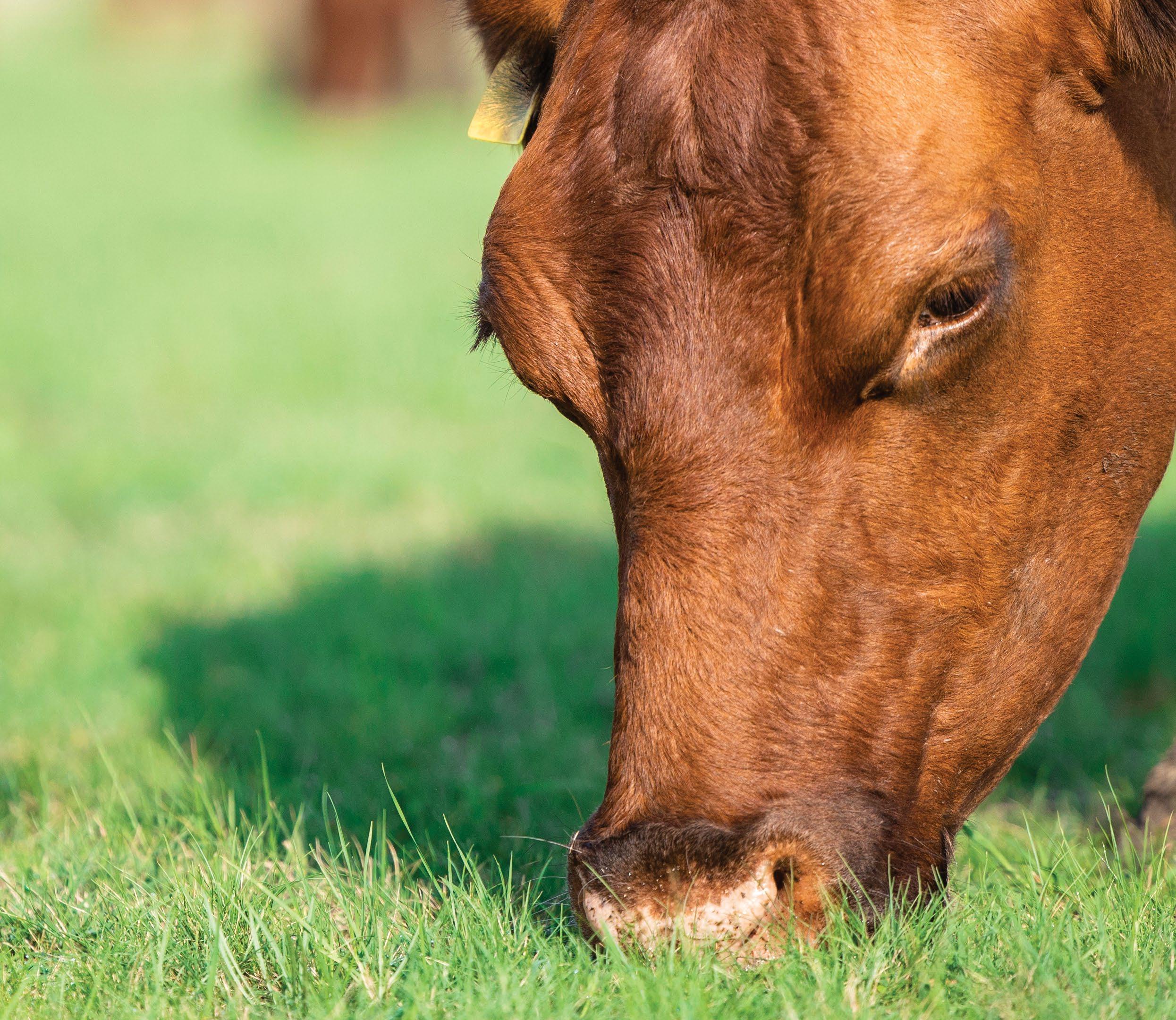

Forage Guide
Regional Account Manager (RAM) Territory
Map
BrettYoung RAMs are spread out across the Prairies to work directly with you in your community and offer product and agronomic support. Reach out to yours with any questions.


Megan Thebeau Megan.Thebeau@brettyoung.ca 587-343-0951
Cole Zacharias Cole.Zacharias@brettyoung.ca 780-886-0799

Al Crozon Al.Crozon@brettyoung.ca 306-916-7701


Clayton Smith Clayton.Smith@brettyoung.ca 780-870-0823


Mark Hagen Mark.Hagen@brettyoung.ca 780-808-9794



Kaiden Bursaw Kaiden.Bursaw@brettyoung.ca 306-750-3248
Erika Olsen Erika.Olsen@brettyoung.ca 403-607-2907
Kent Price Kent.Price@brettyoung.ca 403-803-0182
Kyle Slobodian Kyle.Slobodian@brettyoung.ca 306-291-5256

Chad Abrams Chad.Abrams@brettyoung.ca 204-648-4322

Michael Moore Michael.Moore@brettyoung.ca 204-293-4897

Matt Dykun Matt.Dykun@brettyoung.ca 204-396-4381


Al VanCaeseele Allan.VanCaeseele@brettyoung.ca 306-660-7763
Allan Varjassy Allan.Varjassy@brettyoung.ca 306-230-4387
Provincial Sales Manager
Stock Blend Selector
BrettYoung has carefully crafted our stock blends to give you a high level of productivity over a wide range of environments and uses in Western Canada. Our stock blend selector can help you find the blend best suited to your operation. And though we've put thoughtful agronomics into each stock blend, we know sometimes you need a custom blend to suit your distinct needs. Our RAMs can help create a custom blend perfectly tailored to your requirements. Primary Use
Stock Blend Seeding Rates by Soil Zone
Recommended forage blend seeding rates. Generally, plant populations and consequently, seeding rates, should increase with increasing soil quality and availability of moisture.
Considerations:
• All rates assume Canada #1 Grade for purity and germination
• When broadcasting, seeding rate should increase by approximately 30%
Primarily Grass
#20 - Super PastureHay
#1 - Super Hay
#4 - Super Haymaker
#22Dryland Pasture-Hay
#5 - Pro Hay
Stock Blends
BrettYoung offers a wide variety of stock blends built for Western Canadian conditions.
BrettYoung’s SUPER forage blends are our proven performers. With thoughtful agronomics and years of infield experience, you can count on high yields, outstanding quality, and persistence that can handle whatever conditions are thrown at them.
#2 - Super Maxi-Ton
Blend 4440
Alfalfa (Securus)
Catapult/Purebred Brand Timothy
Hay Blends
#1 - Super Hay
Excellent two-cut alfalfa/grass mix
Blend 4440
Alfalfa (Securus)
CDC Torsion/Fleet Meadow
Bromegrass (Securus)
Catapult/Purebred Brand Timothy
#3 - Saline Hay
Top tonnage in saline soils
Barricade II Alfalfa (Securus)
AC Saltlander Wheatgrass (Securus)
Stronghold Alfalfa (Securus)
SWAJ/Riding Brand Tall Fescue
Dahurian Wildrye
#4 - Super Haymaker
Ideal for one or two-cut systems across most production areas
Blend 4440
Alfalfa (Securus)
CDC Torsion/Fleet Meadow
Bromegrass (Securus)
#5 - Pro Hay
High-yielding alfalfa/grass mix
Blend 4440
Alfalfa (Securus)
AAC Torque Hybrid Bromegrass (Securus)
Catapult/Purebred Brand Timothy
Pasture Blends
#10 - Super Pasture
Excellent early spring pasture, produces well under stress
CDC Torsion/Fleet Meadow Bromegrass (Securus)
Kirk Crested Wheatgrass
SWAJ/Riding Brand Tall Fescue
Shift Alfalfa (Securus)
#12 - All Purpose Pasture
Widely adapted for most pasture needs with easy establishment and quality regrowth
CDC Torsion/Fleet Meadow Bromegrass (Securus )
SWAJ/Riding Brand Tall Fescue
Intermediate Wheatgrass
Foothold Alfalfa (Securus)
#14 - Horse Pasture
Easy to establish, low-maintenance blend, excellent for acreages, farmyards, hightraffic areas, and horse pastures
CDC Torsion/Fleet Meadow Bromegrass (Securus)
Trailburst/Glacier Orchardgrass
Tored Meadow Fescue
Bigbang Annual Ryegrass
Boreal Creeping Red Fescue
Catapult/Purebred Brand Timothy
Tirem Kentucky Bluegrass
#11 - Super Grassland
Maximize regrowth and quality with no risk of bloat, suitable for variable topographies
CDC Torsion/Fleet Meadow Bromegrass (Securus )
SWAJ/Riding Brand Tall Fescue
Boreal Creeping Red Fescue
Trailburst/Glacier Brand Orchardgrass
Catapult/Purebred Brand Timothy
#13 - Parkland Pasture
High-yielding pasture that works well in high traffic areas and aggressive grazing systems
CDC Torsion/Fleet Meadow Bromegrass (Securus)
Trailburst/Glacier Brand Orchardgrass
Shi Alfalfa (Securus)
Boreal Creeping Red Fescue
Tirem Kentucky Bluegrass
#15 - Bloat Safe
Increased quality with no risk of bloat
CDC Torsion/Fleet Meadow Bromegrass (Securus)
Cicer Milkvetch (Securus) Boreal Creeping Red Fescue
SWAJ/Riding Brand Tall Fescue
Go to page 08 of this guide to learn more about Securus, our proprietary seed enhancement.
Dual Purpose Blends
#20 - Super Pasture-Hay
Quick drydown time in a swath
CDC Torsion/Fleet Meadow Bromegrass (Securus)
Trailburst/Glacier Brand Orchardgrass
Catapult/Purebred Brand Timothy
Blend 4440 Alfalfa (Securus)
#22 - Dryland Pasture-Hay
Long-lived productive pasture/hay blend for very dry regions
Kirk Crested Wheatgrass
CDC Torsion/Fleet Meadow Bromegrass (Securus)
Carlton Smooth Brome (Securus)
Foothold Alfalfa (Securus)
Pubescent Wheatgrass
Try our Stock Blend Selector
BrettYoung’s online tool helps you narrow down your stock blend options based on your intended use and soil type.
For more information, go to brettyoung.ca/ stock-blend-selector or scan the QR code.
#21 - Super Cattleman's / Premium Horse Hay
High-protein pasture with superb regrowth, quick to establish, and ideal for horses
CDC Torsion/Fleet Meadow Bromegrass (Securus )
SWAJ/Riding Brand Tall Fescue
Shift Alfalfa (Securus)
Trailburst/Glacier Brand Orchardgrass
Catapult/Purebred Brand Timothy
#23 - Lowland
Excellent blend to reclaim areas prone to flooding, aggressive root systems will help utilize moisture
Reed Canarygrass (Securus)
SWAJ/Riding Brand Tall Fescue
Catapult/Purebred Brand Timothy
Boreal Creeping Red Fescue
Alsike Clover
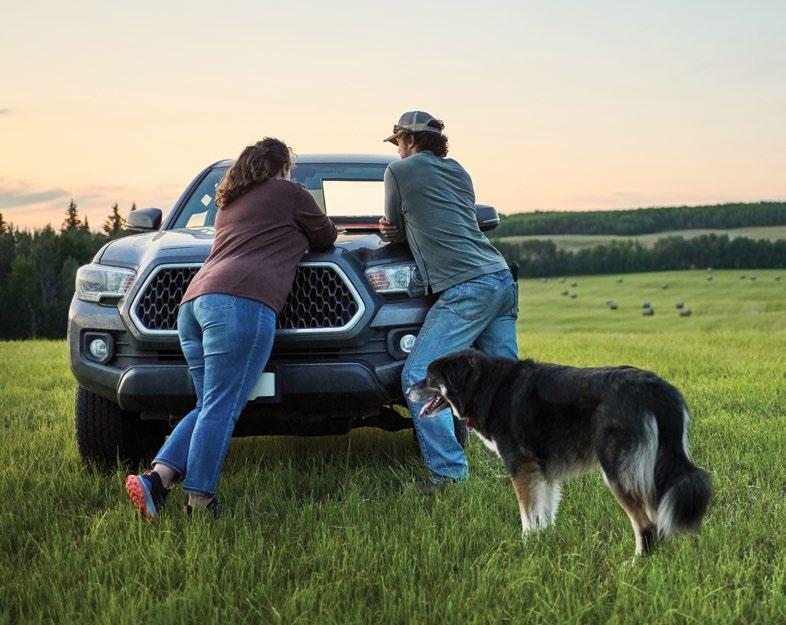
#24 - All Purpose Saline
Quick establishment in saline areas with good longevity and helps reclaim saline areas over time
Slender Wheatgrass Tall Wheatgrass
SWAJ/Riding Brand Tall Fescue
Barricade II Alfalfa (Securus)
Dahurian Wildrye
Sweet Clover
#25 - All Grass Saline
Rapid establishment in saline areas, good longevity, and no risk of bloat
SWAJ/Riding
Brand Tall Fescue
Carlton Smooth Bromegrass (Securus)
AC Saltlander (Securus)
Slender Wheatgrass
Dahurian Wildrye
#26 - Annual Forage EXT
Long-season cocktail crop grazing applications with soil improvement benefits
Mervana Italian Ryegrass Hairy Vetch
Forage Brassica Purebread Brand Radish
Purple Top Turnip

Go to page 08 of this guide to learn more about Securus, our proprietary seed enhancement.
Seed Enhancements
Securus™ is a proprietary seed enhancement used to improve the appearance, handling, and agronomics of our best seed varieties. Securus seed coatings deliver market-leading durability and improved seed flow with less dust-off. Securus is also bacteria friendly and pH neutral, ensuring optimum on-seed survival of rhizobia inoculants.
Securus is partnered with precise layering of Apron XL® LS fungicide to guard against diseases that can inhibit emergence, plant stand, plant health, and ultimately, yield potential. It also includes OMRI-certified Nitragin® Gold inoculant on alfalfa and other legumes to deliver high levels of nitrogen fixation through specially selected natural rhizobia strains.
Benefits of Securus
• Enhanced flowability and seed placement accuracy
• Improved visibility in the soil
• Includes Apron XL LS to aid in seedling health
• Alfalfa treated with Securus also includes Nitragin Gold to support nitrogen fixation

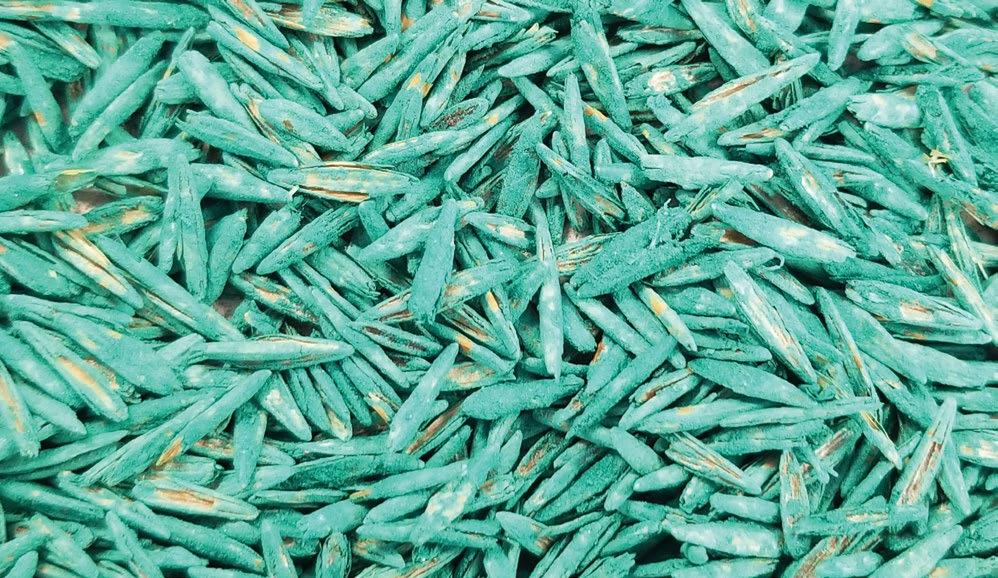

Securus bromegrass
Securus alfalfa
Blend 4440: The Premier Certified Alfalfa Blend for the Canadian Prairies
Blend 4440 is a mixture of premium, certified alfalfas that combine the strengths of our best varieties:
• High yield
• Superior winterhardiness
• Disease resistance
• Salt tolerance
• Traffic tolerance
• Multifoliate expression
• Unique rooting habits
The combination of these unique characteristics makes Blend 4440 suitable for a wide range of growing conditions. Demand the best varietal alfalfa blend in the prairies. Choose Blend 4440.
Blend
Composition
Ace (Tap Root)
Barricade II (Salt Tolerant Tap Root)
Dynamo (Multifoliate)
Foothold (Creeping Root)
Reload (Branch Root)
Shift (Sunken Crown)
Description
Exceptional yield and quality
Salt tolerance with outstanding disease resistance and yield
High multifoliate expression
Spreading root type with exceptional winterhardiness and improved disease resistance
Branch root for optimum performance in poorly drained soils
Deep set crown for excellent persistence and traffic tolerance
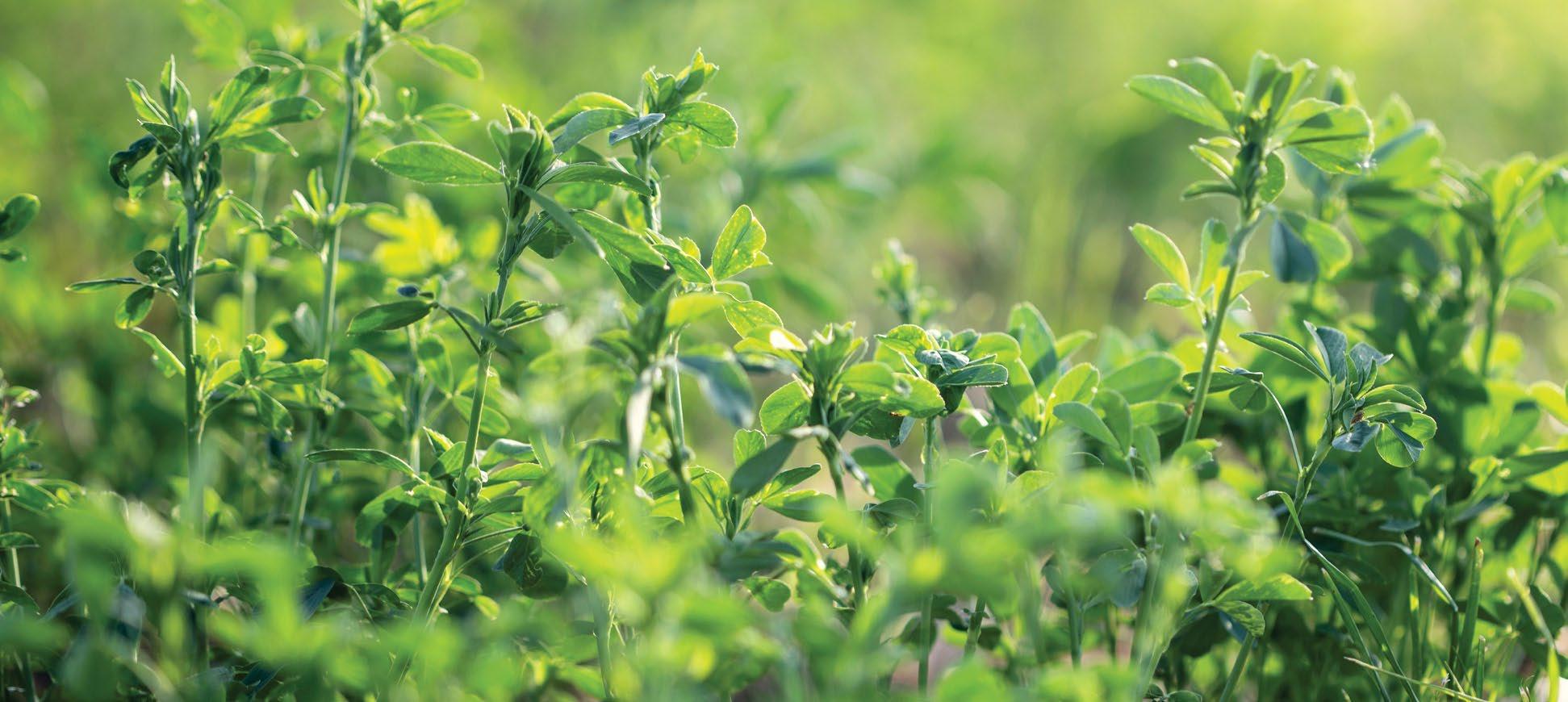
Alfalfa Variety Selector
BrettYoung’s complete portfolio of high-performance alfalfa will meet your every need.
Primary Use of Stand Management System/Intensity
Stand/ Produc on Goal
Recommenda
Pure Stand Alfalfa Seeding Rates by Soil Zone
Generally, plant populations and consequently, seeding rates, should increase with increasing soil quality and availability of moisture.
Considerations:
• All rates assume Canada #1 Grade for purity and germination
• When broadcasting, seeding rate should increase by approximately 30%
Shi
Saline
Barricade II
Alfalfa Varieties
Ace Tap root Upright Widely adapted
Dynamo Tap root Upright Multifoliate Widely adapted
Reload Branch root Upright
Widely adapted; does well with higher water table
Blend 4440 Mixed Upright Widely adapted
• Top forage yields
• Premium quality
• Aggressive regrowth delivering multiple cuts
• High multifoliate expression
• Max tonnage and regrowth
• Exceptional forage quality
• Tolerance to saturated soils
• Improved root protection and durability
• Long and persistent stand life
• Blend of certified varieties
• Widely adapted
• High yield potential
• Excellent winterhardiness
• Disease resistance
Barricade II Tap root Upright
Stronghold Tap root Upright Multifoliate
Surge HG Tap root
Widely adapted; suitable for moderate saline conditions
Widely adapted; winterhardiness and quality
Upright Multifoliate Widely adapted
Shift Tap Root and Deep Set Crown Upright Multifoliate
Foothold Creeping Root and Deep Set Crown Prostrate Multifoliate
Widely adapted; suitable to pasture or longlived hay
Widely adapted; suitable to pasture or longlived hay
• Next-generation salt tolerance
• Improved establishment and vigour in saline conditions
• Excellent winterhardiness
• Excellent yield and quality
• Superior winterhardiness with low dormancy
• Excellent disease resistance
• Hi-Gest™ Alfalfa Technology
• Improved fibre digestion and crude protein
• More pounds of milk per cow
• High traffic tolerance due to deep-set crown
• High forage yield
• Excellent disease resistance package
• High level of multifoliate expression
• High traffic tolerance due to oversized crown
• High leaf-to-stem ratio
• Excellent winterhardiness and disease resistance
• Bloat hazard
• Needs good drainage Spring to Fall
• Bloat hazard
• Needs good drainage Spring to Fall
• Bloat hazard Spring to Fall
• Bloat hazard
• Needs good drainage Spring to Fall
• Bloat hazard
• Needs good drainage Spring to Fall
• Bloat hazard
• Needs good drainage Spring to Fall
• Bloat hazard
• Needs good drainage Spring to Fall
• Bloat hazard
• Needs good drainage Spring to Fall
• Bloat hazard
• Needs good drainage Spring to Fall
Legume Varieties
Group Intended
Birdsfoot Trefoil Leo Tap root with branches Lowgrowing
Cicer Milkvetch Creeping root Upright
Sainfoin
Tap root Upright
Adapted to areas with higher moisture
Widely adapted; creeps best in coarser, textured soils
• Good winterhardiness
• High flood tolerance
• Bloat-free legume
• Widely adapted
• Moderately tolerant to salinity
• Ideal pasture legume
• Bloat-free legume
• Good drought tolerance
Widely adapted to well-drained soils
Alsike Clover Aurora Branch root Lowgrowing Low-lying moist areas
• Good to excellent winterhardiness
• Good tolerance to alkaline soils
• Bloat-free legume
• Tolerant to poorly drained soils
• Excellent winterhardiness
• Flood tolerance
• Fits shorter-term stands
• Difficult to establish
• Difficult to establish
Double-Cut Red Clover Wildcat
Tap root with branches Upright
Red Clover Single-Cut
Tap root with branches Upright
Best suited to areas with good moisture and good drainage; tolerates lower pH soils
Best suited to areas with good moisture and good drainage; tolerates lower pH soils
• Top-yielding red clover
• Strong winterhardiness
• High moisture tolerance
• Limited regrowth
Yellow Blossom Sweet Clover Norgold Tap root Upright
Widely adapted; very productive on well-drained, fertile soils
White Clover Huia Rhizomatous Lowgrowing Prefers heavier, moist soils
• Excellent emergence
• Tolerates acidic soils
• Short-lived perennial
• Low coumarin for reduced risk of bleeding diseases in cattle
• Commonly used as a soil builder
• Good winterhardiness
• Low-growing
• Tolerant to close mowing and grazing
• Bloat hazard; Risk for grazing horses
• Bloat hazard; Short-lived
• Bloat hazard; Short-lived
• Biennial
• Bloat hazard
Bloat-Free Legume
Pasture
Clover Hay & Pasture
Pasture
Tolerances
Forage Grasses
Group Intended
Meadow Brome CDC Torsion Bunchgrass Basal
Meadow Brome Fleet Bunchgras Basal
Widely adapted; prefers welldrained soils
Widely adapted; prefers well drained soils
• Improved yield
• Excellent pasture variety
• Widely adapted
• Excellent regrowth
• Excellent pasture variety
• Widely adapted
• Excellent regrowth
• Excellent winterhardiness
Smooth Brome Carlton Aggressive Sod forming Elongating Widely adapted
Hybrid Brome AAC Torque Sod forming Basal
• Aggressive sodforming roots
• Slow regrowth
• Widely adapted
• Exhibits disease resistance
Widely adapted
Creeping Red Fescue Boreal Sod forming Basal
Meadow Fescue Tored Bunchgrass Basal
Widely adapted; does best in high rainfall areas
• Cross of meadow and smooth bromegrass
• Suited to hay and pasture
• Does well with wide range of soil types
• Is most productive under high-moisture conditions
• Tolerates close grazing and survives drought
Prefers soils with good moisture and good drainage
Tall Fescue SWAJ Bunchgrass Basal
Tall Fescue Riding Brand Bunchgrass Basal
Excellent tolerance to harsh winter conditions (frost, snow, and ice)
Widely adapted; does best in moist, heavy textured soils
• Basal leaf growth suitable for grazing
• Tolerant to acidity
• Soft-leaved palatability
• Outstanding winterhardiness
• Crown rust resistance
• High yield
• Endophyte free
• Excellent heat and drought tolerance
• Endophyte free
• Good seedling vigour
• Adapted to a variety of soil types
• Poor tolerance to flooding
• Poor tolerance to flooding
• Considered an invasive species in many range areas
• Slower regrowth than Meadow Brome
• Low production under drier conditions
• Not always winterhardy
• Widely adapted; does best on moist, heavy textured soils
• Not always winterhardy
Bromegrass (C3)
Fescue (C3) Hay & Pasture
Forage Grasses
Species
Kentucky Bluegrass Tirem
Sod forming Basal
Perennial Ryegrass Tribal Bunchgrass Basal
Reed Canarygrass
Sod forming Elongating
Orchardgrass AC Killarney Bunchgrass Basal
Preferred
Orchardgrass Trailburst Bunchgrass Basal
Does best on well drained, highly productive soils
Medium to high fertility soils with adequate moisture
Grows well on poorly drained soils prone to flooding
Prefers medium textured, welldrained soils with good moisture
Prefers medium textured, welldrained soils with good moisture
• Long-lived
• Highly palatable
• Tolerance to flooding and close grazing
• Very leafy bunchgrass
• High quality forage
• Susceptible to winterkill
• Requires high fertility
• Low alkaloid variety
• Can be subjected to temporary flooding up to eight weeks
• Excellent winterhardiness
• Improved winterhardiness
• Late maturity
• Dense leafy production
• Selected for vigour and plant health
• High forage quality and palatability
• High yields
• Strong seedling vigour
• Does not tolerate drought
• Very susceptible to winterkill
Timothy Catapult Bunchgrass Basal
Timothy Impactor Bunchgrass Basal
Adapted to cool, moist areas; good tolerance to waterlogged soils
Adapted to cool, moist areas; good tolerance to waterlogged soils
Timothy Brute Bunchgrass Basel
Timothy Purebred Brand Bunchgrass Basel
Adapted to cool moist areas; good tolerance to waterlogged soils
Adapted to cool moist areas; good tolerance to waterlogged soils
• Excellent summer regrowth
• Stand persistence
• Exceptional yield
• Excellent standability
• Dark green colour
• Disease resistance
• Great forage quality
• Late maturity,
• High yields,
• Very good winterhardiness,
• Great forage quality
• Medium maturity
• High yields
• Very good winterhardiness
• Not saline tolerant
• Not always winterhardy
• Not saline or drought tolerant
• Not tolerant to continuous grazing
• Not saline or drought tolerant
• Not tolerant to continuous grazing
• Not saline or drought tolerant
• Not tolerant to continous grazing
• Not saline or drought tolerant
• Not tolerant to continous grazing
Forage Grasses
Crested Fairway Bunchgrass Basal
Crested Kirk Bunchgrass Basal
Widely adapted; does best in medium to coarse, well-drained soils; does better than standard types under more moist conditions
Widely adapted; does best in medium to coarse, well-drained soils
• Diploid type
• Finer-stemmed
• Tolerates more moisture
• Tetraploid type
• Tolerant to heavy grazing
• Aggressive vigour and high yields
• Forage quality drops after heading
Intermediate Slow Sod forming Elongating
Pubescent Greenleaf Slow Sod forming Elongating
Widely adapted; prefers welldrained soils with adequate moisture
Widely adapted; prefers welldrained soils with adequate moisture
• Deep-feeding root system
• Produces excellent pasture yields
• Short-lived under intensive use
• Widely adapted
• Moderately tolerant to salinity
• Good in mixtures with alfalfa
• Dewaters saline areas and spreads out
• Forage quality drops after heading
• Shorter lived under intensive management
• Shorter lived under intensive management
Hybrid AC Saltlander Rhizomatous, creeping root Elongating
Adapted to saline and alkaline soils
• Palatable and nutritious hay or pasture
• Competes with foxtail barley and downy brome
Slender Bunchgrass Elongating
Tall Bunchgrass Basal
Dahurian Wildrye Bunchgrass Basal
Adapted to a wide range of soils; prefers welldrained loam soils
Adapted to poorly drained alkali soils; prefers a high water table
Widely adapted but short-lived
• Saline tolerant
• Spring flood tolerant
• Excellent winterhardiness
• Good flood tolerance
• Very tolerant to saline soil conditions
• Very vigorous seedlings
• Used in hay and pasture mixes for establishment
• Fair to good forage quality
• Short-lived perennial
• Lower palatability
• Short-lived perennial
Hay & Pasture
Wheatgrass (C3)
Wildrye (C3) Intended
Understanding Warm and Cool Season Forage Grasses
One of the ways forage grasses can be characterized is into cool-season and warm-season groups, often referred to as C3 and C4 grasses. Knowing what makes these groups unique and where they are best suited can help you pick the right one for your farm, so here are some details on these distinct groups of grasses.
C3 Grasses (Cool Season Grasses)
C3 plants utilize the Calvin cycle for carbon fixation. They are named "C3" because the first product of carbon fixation is a 3-carbon compound (3-phosphoglycerate).
C3 grasses are the predominant type throughout Western Canada, including ryegrass, fescue, orchardgrass, bromegrass, and timothy. They thrive in cool, moist environments, performing best in spring and fall, and often go dormant or decline in productivity during hot, dry summers.
Benefits of C3 Forage Grasses
C3 grasses typically have higher forage quality, including higher levels of protein and digestible fibre than C4 grasses. They are productive in the spring and can continue producing into the cooler months of fall, providing a long production season. Most are well adapted to Western Canada and are winterhardy, producing year after year.
Weaknesses
of C3
Forage Grasses
During hot, dry summers, growth may slow significantly or stop altogether. They are also less efficient with their water use compared to C4 grasses.
C4 Grasses (Warm Season Grasses)
C4 plants use a different pathway (Hatch-Slack pathway) that efficiently concentrates CO ₂ in specialized leaf cells, resulting in a 4-carbon compound.
C4 grasses are less common in Western Canada but can be used as annual forage options, which includes corn, sorghum, and millet. They thrive in warm, sunny environments and are heat-tolerant and drought-resistant.
Benefits of C4 Forage Grasses
C4 grasses excel under high temperatures and low rainfall. Their ability to grow vigorously in the summer allows them to produce high forage yields.
Weaknesses of C4 Forage Grasses
Compared to C3 grasses, C4 species often have higher fibre and lower protein and digestibility, which may not meet the nutritional needs of high-producing livestock. They are not winterhardy in Western Canada and must be replanted each season into warm growing conditions for successful germination and plant growth.
Summary
C3 and C4 forage grasses both offer distinct advantages and are valuable components of a welldesigned forage system. Choosing the right species — or combination of — for your location and livestock requirements can greatly maximize your productivity.
BrettYoung offers a full forage lineup, including a wide range of cool-season and warm-season grasses. For help finding the right forage grass for your farm, contact your BrettYoung Regional Account Manager.
Annual Forage Stock Blends
Annual forages offer flexibility, quick establishment, and high yields when you need to increase feed availability quickly to supplement your perennial forage. Many species also help improve soils and can be used as a cover crop or an annual forage, depending on your farm’s specific needs.
BrettYoung offers several annual forage blends, including custom blends, to give your operation what it needs.
#26
- Annual Forage EXT
Long-season cocktail crop grazing applications with soil improvement
Italian Ryegrass
Brand Radish
Sprint Maxx
A blend of specially selected forage oats and forage peas, giving you high yields in dairy and beef operations
Brassica
Tripper Maxx
An elite forage blend of specially selected forage peas and spring triticale, delivering you the benefits of a forage legume and cereal in one product
Peas
Cover Crops
In a cover crop application, forages are planted primarily for soil improvement benefits like erosion control, soil health, and biodiversity. Most cover crop blends are comprised of multi-species annual forages including ryegrasses, brassicas, and legumes like vetch or clover to fix nitrogen.
Forage Peas
Forage Oats
Spring Triticale
Forage
Purple Top Turnip
Forage
Purebread
Mervana
Hairy Vetch
Annual Forages & Cover Crops
Sorghum Sudangrass Sorghum Sudangrass Fibrous Warmseason grass
Millet Golden German Fibrous Warmseason grass
Millet Red Proso Fibrous Warmseason grass
Millet Japanese Fibrous Warmseason grass
Annual Ryegrass Bigbang Bunchgrass Basal
Italian Ryegrass Mervana Bunchgrass Basal
Forage Radish Purebred Brand Radish Tap Brassica
Turnip Purple Top Turnip Tap Brassica
Prefers warm soil and growing conditions
Prefers warm soil and growing conditions
Prefers warm soil and growing conditions
Prefers warm soil and growing conditions
Soil of medium to high fertility with adequate moisture
Soil of medium to high fertility with adequate moisture
Prefers well-drained soils and cool growing conditions
Prefers well-drained soils and cool growing conditions
• Triazine tolerant
• High yields
• High feed quality
• Better suited for hay than other millet
• Fast growing, widely adapted
• Highest yielding millet
• Prefers heavier wet soil
• Tetraploid type
• Very leafy bunchgrass
• Suitable for annual hay production in highmoisture areas
• Tetraploid type
• Outstanding summer growth
• Great disease resistance, including HR to rust
• In-season and lateseason grazing
• Soil improvement
• Oilseed type
• In-season and lateseason grazing
• Soil improvement
Forage Brassica Forage Brassica Tap Brassica
Prefers well-drained soils and cool growing conditions
• In-season and late season grazing
• Nitrate risk
• Nitrate risk
• Nitrate risk
• Nitrate risk
• Prone to drought stress
• Prone to drought stress
Annual Forages & Cover Crops
Hairy Vetch Shallow Tap Root Upright
Crimson Clover Tap Root Upright
Well suited to sandy, well drained soils
Thrives in well drained sand and clay soils
Berseem Clover Shallow Tap Root Upright Slightly alkaline loam and silty soils
• Excellent nitrogen fixer
• High protein content
• Highest shade tolerance of legumes
• Sprawling vine biomass production
• Limited tolerance to drought
• Consumption of seed can be poisonous to livestock
• Not adapted to poorly drained soils
• Natural resistance to glyphosate
• Slow establishment and regrowth
• Nitrogen fixer
• Biomass production
• More resistant to disease and nematodes than other clovers
• Strong tap root that will survive well in blends
• Aggressive warm season growth
• Does not cause bloat
• Nitrogen fixer
• Big biomass production
• Cannot tolerate extreme heat or cold
• Low tolerance to drought
• Does not overwinter
• Slight bloat risk
• Does not overwinter and susceptible to frost
• Does not grow well in sandy soils
• Can be slow to establish in spring
• Little regrowth
• Low tolerance to disease
Corn Hybrids
As Western Canada’s forage leader, we’ve specifically designed our corn lineup for silage and grazing on your farm. That’s why you can trust our corn hybrids to deliver the consistent and trusted performance the BrettYoung brand has stood for for generations.


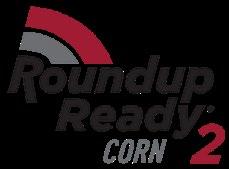
High Performance with Broad Adaptation
• High-yielding flint/dent ideal for silage and grazing
• Widely adapted for use across Western Canada
• White cob hybrid with excellent grain quality and slow drydown for a wider harvest window
Genetic Trait: Roundup Ready® Corn 2
Relative Maturity: 78
Grain CHU: 2250
Silage CHU: 2150
Spring Vigour: Good
Plant Height: Medium-tall
Stalk Strength: Very Good
Root Strength: Very Good
Drought Tolerance: Very Good
Silage Potential: Excellent
Ear Type: Semi-flex
Husk Cover: Good
Test Weight: Excellent
Drydown: Slow
Target Population: 30–34 K
Northern Corn Leaf Blight: Good
Goss’s Wilt: Good
Great Performance with Insect Resistance
• High-yielding flint/dent ideal for silage and grazing
• Excellent late season stay-green and eye appeal with good stalks and roots
• Early flowering white cob hybrid with high grain quality and slow drydown
• Consistent ear development down the row
Genetic Trait: VT Double PRO® RIB Complete® Corn
Relative Maturity: 78
Grain CHU: 2250
Silage CHU: 2150
Spring Vigour: Good
Plant Height: Medium-tall
Stalk Strength: Very Good
Root Strength: Very Good
Drought Tolerance: Very Good
Silage Potential: Excellent
Ear Type: Semi-flex
Husk Cover: Good
Test Weight: Very Good
Drydown: Slow
Target Population: 30–34 K
Northern Corn Leaf Blight: Good
Goss’s Wilt: Good


Consistent High Performance
• High-yielding hybrid well suited for silage and grazing in longer season areas
• Excellent root and stalk strength
• Broadly adapted to various soil types
• Impressive disease tolerance, including very good resistance to Goss's Wilt
Genetic Trait: Roundup Ready® Corn 2
Relative Maturity: 83
Grain CHU: 2450
Silage CHU: 2350
Spring Vigour: Very Good
Plant Height: Medium
Stalk Strength: Excellent
Root Strength: Very Good
Drought Tolerance: Very Good
Silage Potential: Very Good
Ear Type: Semi-flex
Husk Cover: Good
Test Weight: Good
Drydown: Average
Target Population: 30–34 K
Northern Corn Leaf Blight: Very Good
Goss’s Wilt: Very Good
Turf Grass Blends
Our portfolio of improved turf grass varieties is designed to offer the utmost in quality, disease and insect resistance, wear and drought tolerance, and unique growth habits that will deliver a distinct performance advantage. Whatever turf application you have, BrettYoung has the turf blends to meet your needs.
Deluxe Turf Blend (T12)
The benefits of Kentucky bluegrass meet the improved turf characteristics and shade tolerance of creeping red fescue
Executive Blend (T8)
A mixture of our best Kentucky bluegrass varieties that combines fine leaves, less vertical growth, persistence, heat tolerance, disease resistance, and excellent turf quality
Drought Tolerant Turf Blend (T9)
Kentucky Bluegrass
Creeping Red Fescue
Perennial Ryegrass
Premium Kentucky Bluegrass Varieties

Includes improved drought tolerant varieties of creeping red fescue, chewings fescue, and hard fescue for a dense, high-quality turf grass
All Purpose Mix (T6)
Well suited to sun or shade, this mix reduces turf quality and provides an economical option for lawn establishment
Ryegrass Kentucky Bluegrass
Creeping Red Fescue
Playground/Rural Lawn Mix (T3)
For areas that require less maintenance, can experience drought, and do not require the look of a high-quality turf
Bluegrass Creeping Red Fescue
Fescue
Fescue
Establishing Your Lawn
Here are some tips to make sure your lawn establishes:
• Seed at four pounds per 1,000 square feet
• Use a high-quality starter fertilizer: 18-24-12 with 50% slow-release nitrogen is ideal at a rate of ten pounds per 1,000 square feet
• Grass seed needs water and light to germinate. Seed shallow and frequently water at low rates for three to four weeks until full germination is reached
Executive Blend (T8)
Deluxe Turf Blend (T12)
All Purpose Mix (T6)
Drought Tolerant Turf Blend (T9)
Playground/Rural Lawn Mix (T3)

How to Establish a Productive Forage Stand
The establishment phase is the critical first step in a productive and healthy forage stand. To improve your likelihood of establishment success, follow the agronomic guidelines below.
Time of Seeding
Early spring (mid-April to early June), midsummer (mid-July to early August), and late fall (after freeze-up) are suitable times for seeding forages. Spring seeding provides the best chance for adequate moisture levels and successful germination. Summer seeding provides less weed competition but a greater likelihood of less moisture. Fall dormant seeding runs the risk of early spring runoff or freeze/thaw patterns harming seedlings.
Seedbed Preparation
A firm, well-prepared seedbed is required for good forage establishment. This results in proper seed-to-soil contact, adds control to seeding depth, and reduces surface drying.
Weed Control
Weed control is essential for good forage establishment. A seedbed free of perennial weeds is critical to minimize seedling and in-crop competition. Control weeds prior to seeding as well as during the year of establishment.
Quality Seed and Seed Coatings
Certified seed guarantees quality, including varietal purity, germination, and weed-free seed.
The agronomic benefits of certified seed are seen in the field through defined varietal characteristics and quality assurance, strong seedling germination, improved plant populations, and reduced weed competition. Consider a seed coating to improve handling, visibility in the soil, and to protect your investment from seed and soil-borne diseases. All legumes, if possible, should be inoculated to ensure proper nitrogen fixation.
Seeding Depth
Proper depth of seeding cannot be stressed enough. Many forage establishment failures are due to seeding too deep. All forage species should be seeded no deeper than one-half inch. Most forage seeds will do well planted at about one-quarter inch or less. Always err on seeding shallow rather than deep.
Seeding Rates
Use the proper seeding rates calculated by number of seeds per square foot. Seeding rates depend on species, seed size, seed quality, seeding method, row spacing, and annual precipitation. Because most forage seeds are small, light, and often chaffy, it can be useful to mix the seed with cracked grain, companion crop seed, or coated seed to improve seed flow.
Visit brettyoung.ca/forageseeding for more information.
Fertility
Soil test and fertilize accordingly. Remember the most cost-effective time to fertilize a forage crop is usually at seeding. Consider the use of higher rates of phosphorus or elemental sulphur to provide a stable nutrition base for the following years. 15 lb per acre of P2O5 can be safely seed-placed. Higher rates must be banded away from the seed row to avoid seedling damage.
General Fertility Guidelines for Forage
Source: www.agriculture.alberta.ca
Companion Crops
Many growers choose to plant forages with a companion crop like barley or oats to provide production in the establishment year. Companion crops compete with new forage seedlings for sunlight, nutrients, and moisture. A companion crop can reduce seedling establishment and plant populations, adversely affecting forage yield and stand longevity. The benefits of using companion crops include reduction of wind and water erosion and reduction of weed infiltration. If using a companion crop, the following tips will reduce the competition and aid in forage stand establishment.
Tips for Using Companion Crops in Establishment
Tip #1 – Seed the companion crop at one-third to one-half of normal seeding rate (when using cereals, 30 lbs/acre is ideal).
Tip #2 – Seed forage in a separate pass at an angle to your companion crop to reduce competition and to aid in-depth control.
Tip #3 – Increase your forage seeding rate to achieve desired plant densities in the stand to compensate for the companion crop.
Tip #4 – Remove the companion crop as early as possible (silage or greenfeed) rather than harvesting the grain.
Tip #5 – If harvesting the companion crop for grain (not recommended), remove all straw from the field. If that is not an option, chop and spread the straw thoroughly across the field. If straw is left in a windrow, it will smother the emerging forage seedlings.
Tip #6 – If seeding forage where soil erosion is prominent, it's recommended that you use a companion crop. The companion crop will aid in covering and protecting the soil during the establishment year.
Species Selection & Adaptation
Forage Crop Use Recommendations
Consider the following factors when selecting forage species:
Intended Use and Management System
• Is the intended use hay or pasture?
• In hay stands, how many cuts do you expect to take each year?
• In pasture, how intensely will the forage crop be grazed?
• Are you rotational or continuous grazing?
Forage Timing
• When would you like your forage to be available?
Environmental Conditions
• How much annual precipitation does your area receive?
• How harsh are your winters?
Soil Type
• What is your soil type (sand, clay, loam)?
• How well does your soil drain?
• Is there a problem with saline or alkaline soils?
• Is the organic matter content high or low?
For information on variety and species characteristics with respect to environmental conditions and soil type, see the detailed tables on pages 14 to 23 and 26 to 29 of this guide.
Acidity:
Poor = Sensitive to acidity
Excellent = Tolerant to below pH 5.0
Salinity: Poor = Sensitive to low salt, below EC (dS/m) of 4
Excellent = Tolerant up to EC (dS/m) of 12 - 16
Pasture regrowth rate indicates time to regrow rather than amount of regrowth.
Forage Species
for Hay Alfalfa
W. CDN Productivity
Producing Seed for BrettYoung

Forage and turf seed production is an excellent way to diversify your risk and add profitable cropping options to your rotation. When you partner with BrettYoung, we help you with every step, from planning and production to harvest and delivery.
Seed Production Territory Map

Kerry Dusik VP, Seed Production & Sourcing kerry.dusik@brettyoung.ca 1-800-665-5015

Mac Tkacik mac.tkacik@brettyoung.ca 587-348-4235

Scott Davie scott.davie@brettyoung.ca 204-212-1025

Jordan Schmidt jordan.schmidt@brettyoung.ca 403-360-6969

Doug Senko doug.senko@brettyoung.ca 306-401-0138

Cord Ferguson cord.ferguson@brettyoung.ca 204-807-5369

Allan Wilson allan.wilson@brettyoung.ca 204-294-6547
Okatoks
Medicine Hat
Lethbridge
Red Deer
Benefits of Forage and Turf Seed Production
Forage and turf seed production offers many advantages to your farm. BrettYoung works with a wide range of species and can provide unique seed production opportunities to fit your farm’s needs.
Grass Seed Production
Available species are Perennial Ryegrass, Tall Fescue, Annual Ryegrass, Fine Fescue, Meadow Fescue, Timothy, and Bromegrass.
Benefits include:
• Early harvest splits up the fall workload
• Increases organic matter to improve soils
• Some species have tolerance to salinity, alkalinity, and acidity
• Perennial options with multiple crop years, reducing the planting season workload
Legume Seed Production
Available species are Alfalfa, Clover, and Trefoil.
Benefits include:
• Improves soil health
• Low inputs
• Nitrogen fixation
• Rotational benefits for following annual crops
• Multiple crop years reduce the planting season workload
Economic Benefits
Forage and turf seed production has an excellent profitability track record. BrettYoung’s seed production contracts allow growers to lock in a minimum price without limiting upside, helping add to your bottom line.

BrettYoung's dedicated team of Seed Production Specialists is here to guide you with every aspect of forage and turf seed production to help you maximize your field's potential.
Planning Production Harvest Delivery
• Scouting and field selection
• Species selection
• Cover crop recommendations
• Production planning
• Contract terms
• Delivery of stock seed
• Field scouting
• Fertility recommendations
• Herbicide, fungicide and growth regulator recommendations
• Harvest timing recommendations
• Equipment setting recommendations
• Crop sample collection
• Post-harvest recommendations
• Communication of delivery schedule
• Communication of quality analysis
• Communication of grower payments
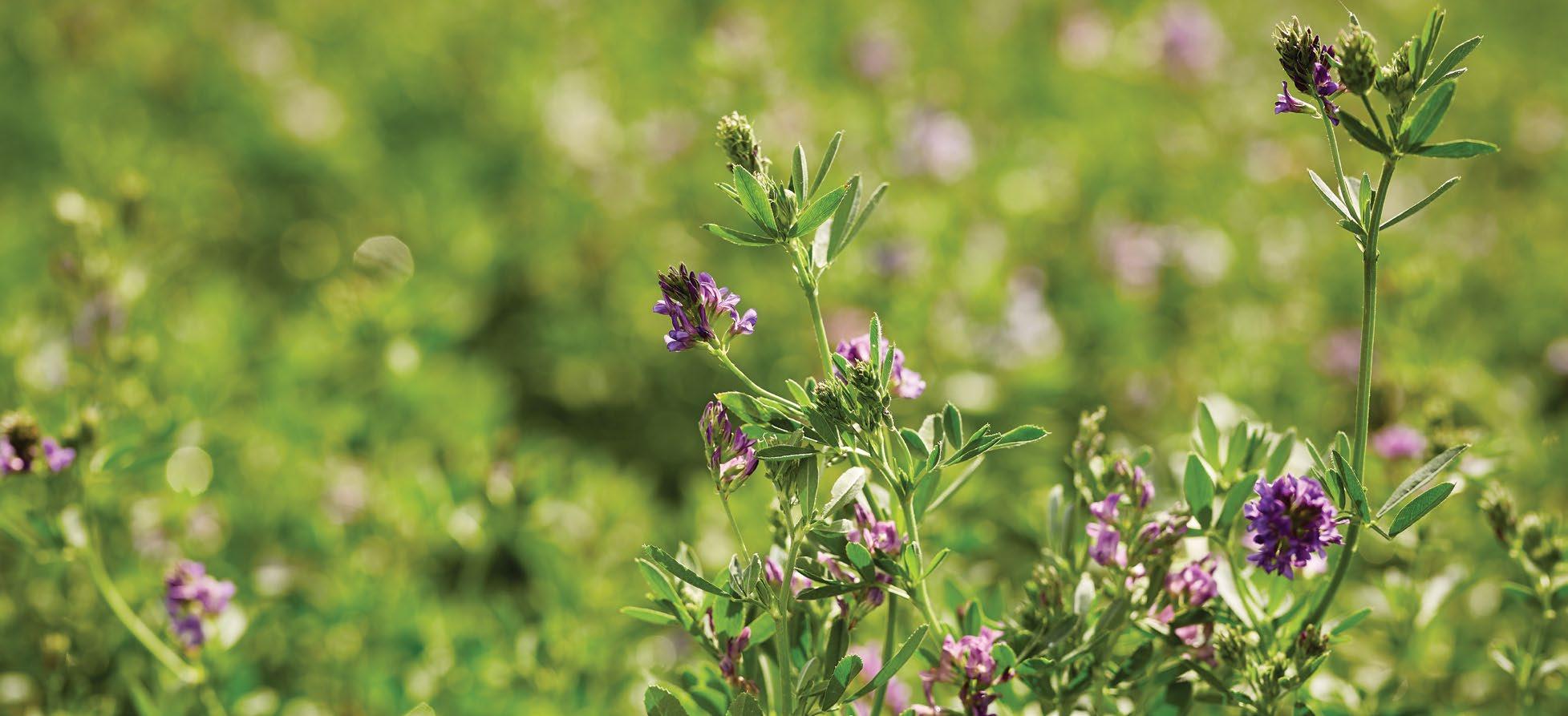
Seed Grower Partnership Program
The Seed Grower Partnership Program (SGPP) provides BrettYoung seed growers with tools to help manage risk and maximize the profitability of forage and turf seed production.
Ask a Seed Production Specialist about SGPP and how you can qualify.
BrettYoung Forage Establishment Guarantee
Though you’ve taken care to properly seed and establish your new forage stand, the weather doesn't always cooperate. Not to worry; in the unfortunate event of establishment failure, your replacement seed cost is covered by BrettYoung. Percent coverage depends on when you enroll in the program, place your seed order, and if you used a companion crop.
Program Eligibility Criteria
To be eligible for the program, the following criteria must be met:
• Order seed and enroll in the program by April 1, 2026 and seed without a companion crop to qualify for 100% coverage on replacement seed
• If a companion crop is used along with the April 1, 2026 enrollment period, replacement seed coverage is 50%
• Enroll in the program by April 30, 2026 and seed without a companion crop to qualify for 50% coverage on replacement seed
• If a companion crop is used along with the April 30, 2026 enrollment period, replacement seed coverage is 25%
Forage Guarantee Key Dates
April 1, 2026 : Deadline to order seed and enroll in the program to be eligible for 100% coverage.
April 30, 2026 : Deadline to enroll in the program to be eligible for 50% coverage.
June 30, 2026 : Seeding deadline on all qualifying forage stands.
Within 60 days of seeding or July 30, 2026 : Deadline to notify BrettYoung RAM of stand establishment concerns.
• Stand must be planted by June 30, 2026
• Products or blend components used must qualify for the program
• Must fulfill Agronomic Requirements as outlined on the next page
Program Limitations
• Replacement seed under the Forage Establishment Guarantee is provided only once for the area of the stand that failed to establish and must be seeded in that area.
• Replacement seed will be the same variety or mixture as originally purchased, subject to availability.
• Replacement seed must be planted during the original year of seeding or during spring of the following year.
• Saline products are not eligible for the Forage Establishment Guarantee.
• Seeding rates for cereal companion crops must not exceed 30 lb/acre.
• Good agronomic seeding preparations and stand establishment practices must be followed and documented as outlined on the opposite page.
Online Registration
Complete the Forage Establishment Guarantee registration form to enroll in the program. Be sure to register and buy qualifying BrettYoung forage seed before April 1, 2026 to be eligible for 100% coverage.
Download your registration form today at brettyoung.ca/ establishment-guarantee
Agronomic Requirements
To receive replacement seed of qualifying varieties, all of the seeding preparation and agronomic practices noted below must be followed and documented.
Time of Seeding
Forage seed must be planted before June 30, 2026. If a companion crop is used in the establishment year, the seeding rate must be reduced to one-half or less of the normal recommended seeding rate and harvested as greenfeed or silage. To reduce lodging and severe competition from the companion crop, the soil nitrogen and applied nitrogen must not exceed 50 lb of actual nitrogen per acre.
Seedbed Preparation
Seed must be planted in a firm, well-prepared seedbed that has undergone proper weed control, crop residue management, and good seed-to-soil contact.
Seeding Depth and Packing
Forage seed must be seeded to a depth of one-half to one-quarter inch. Broadcast seeding operations must be incorporated and packed immediately, no deeper than the noted depth.
Seeding Rates
Minimum seeding rates appropriate for the cropping zones and area must be followed. In the drier regions, the minimum rate is eight pounds per acre for hay and pasture mixes. In higher moisture
Companion Crop
regions, the minimum is 12 lb per acre for hay and pasture mixes.
Weed and Insect Infestation
The Forage Establishment Guarantee is not available in the event of excess weed competition or insect infestation. Preventative action must be taken to control weed infestation. Reasonable control and monitoring of insects, mainly grasshoppers, is required.
Fertility and Soil pH
Soil pH for alfalfa plantings must be within a range of 6.5 to 8.5. A soil test showing satisfactory soil conditions must be available. Forage seed planted in an area where improper fertility and soil pH are present will be ineligible for coverage.
No more than 15 lb of P205 should be placed in the seed row with the seed. Higher rates must be banded away from the seed row to avoid seedling damage.
Chemical Residue
Stand damage due to chemical residue is not eligible for coverage.
Stand Evaluation
Your BrettYoung RAM must be notified of establishment failure within 60 days of seeding or by July 30, 2026 . By this date, with corrective management such as weed or insect control, the forage stand will establish to its full potential.
If a companion crop is used, it must be seeded at one-third to one-half of the normal seeding rate. Seeding rates for cereal cover crops including wheat, barley, oats, rye, and triticale should not exceed 30 lb/acre. Annual ryegrass can be used as a cover crop without reduction in coverage if the seeding rate does not exceed 2 lb per acre. Seed forages in a separate pass at an angle to your companion crop to reduce competition and to aid in depth control. Remove the companion crop as early as possible rather than harvesting the grain. This will reduce the amount of competition for sunlight, moisture, and nutrients.
BrettYoung™ and Securus™ are trademarks of Brett-Young Seeds Limited.
Bayer is a member of Excellence Through Stewardship® (ETS). Bayer products are commercialized in accordance with ETS Product Launch Stewardship Guidance, and in compliance with Bayer’s Policy for Commercialization of Biotechnology-Derived Plant Products in Commodity Crops. These products have been approved for import into key export markets with functioning regulatory systems. Any crop or material produced from these products can only be exported to, or used, processed or sold in countries where all necessary regulatory approvals have been granted. It is a violation of national and international law to move material containing biotech traits across boundaries into nations where import is not permitted. Growers should talk to their grain handler or product purchaser to confirm their buying position for these products. Excellence Through Stewardship® is a registered trademark of Excellence Through Stewardship.
ALWAYS READ AND FOLLOW PESTICIDE LABEL DIRECTIONS. It is a violation of federal law to use any pesticide product other than in accordance with its labeling. Roundup Ready 2 Technology contains genes that confer tolerance to glyphosate. Glyphosate will kill crops that are not tolerant to glyphosate. RIB Complete®, Roundup Ready 2 Technology and Design®, Roundup Ready®, Roundup®, and VT Double PRO® are registered trademarks of Bayer Group. Used under license. Bayer CropScience Inc. is a member of CropLife Canada.
BrettYoung HEAD OFFICE
Canada R3V 1L5
Toll-Free: 800-665-5015

